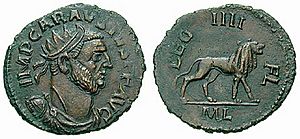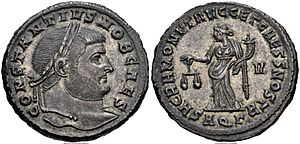Carausian revolt facts for kids
The Carausian Revolt (286–296 AD) was a time in Roman history when a Roman naval commander named Carausius decided he wanted to be emperor. He took control of Britain and parts of northern Gaul.
In 293 AD, the western Caesar Constantius Chlorus took back the lands Carausius held in Gaul. After this, Carausius was killed by his own officer, Allectus. Britain was finally brought back into the Roman Empire in 296 AD by Constantius and his helper, Asclepiodotus.
Contents
How the Revolt Started
Carausius came from a simple background but rose through the ranks of the Roman military. He was put in charge of a naval fleet at Bononia (Boulogne). His job was to stop Frankish and Saxon pirates from raiding ships in the English Channel.
However, some people said Carausius was working with the pirates to get rich. Because of these accusations, the western Augustus (a higher-ranking emperor), Maximian, ordered Carausius to be killed. Instead of obeying, Carausius declared himself emperor in Britain.
His forces included his own fleet, new ships he had built, and the three legions already in Britain. He also took control of a legion in Gaul. Many other groups joined him, like foreign helper units, Gaulish merchant ships, and barbarian fighters who wanted to share in any treasures they found.
Around 288 or 289 AD, Maximian tried to invade Britain to remove Carausius. However, this invasion failed, possibly due to bad weather. Carausius claimed it as a military victory. Some historians say that Carausius was very skilled in battle, and eventually, peace was agreed upon.
Carausius's Empire in Britain

After successfully defending his power, Carausius wanted his rule to be seen as official and recognized by the other Roman emperors. He started making his own coins. He made sure their value was the same as official Roman coins. He even honored Maximian and later Diocletian on his coins. This shows he might have wanted to make peace with them.
Carausius also tried to appeal to the local people in Britain who were unhappy with Roman rule. He put phrases on his coins like Restitutor Britanniae (Restorer of Britain) and Genius Britanniae (Spirit of Britain). Before this, Britain had been part of the Gallic Empire, which was a separate empire formed in 260 AD that included Gaul and Hispania. The Roman Empire had only just taken Britain back in 274 AD. A stone found in Carlisle with Carausius's name on it suggests he controlled all of Roman Britain.
Rome Takes Back Control
In 293 AD, Constantius Chlorus, who was now the western Caesar, began to isolate Carausius. He took back the lands Carausius held in Gaul. Constantius then surrounded the port of Bononia. He built a large wall across the harbor mouth to stop Carausius's ships from escaping or getting help from the sea. He also invaded Batavia, a region near the Rhine River, to secure his position against Carausius's allies, the Franks.
However, it was not possible to invade Britain right away. A new fleet of ships had to be built first. Carausius had been in power for seven years when he was killed by his own officer, Allectus, who then took command.
Three years later, in 296 AD, the Roman Empire began to take back Britain. Maximian was guarding the Rhine River border. Constantius divided his fleet into several groups. He led one group himself from Bononia. Another group, sailing from Le Havre, was led by Asclepiodotus, a high-ranking officer.
Allectus placed his fleet near the Isle of Wight. But a thick fog allowed Asclepiodotus's ships to pass by without being seen. Asclepiodotus landed near Southampton and burned his ships. This meant his soldiers had to fight and could not retreat.
Allectus's rebels were forced to move away from the coast. But as they did, they ran into another Roman fleet and were defeated. Allectus himself was killed in the battle. He had removed all his emperor's symbols so his body would not be recognized. Archaeologists believe his defeat happened at Calleva Atrebatum (Silchester).
A group of Roman soldiers, who had been separated by the fog during the crossing, caught up with the remaining rebels, mostly Franks, in Londinium (London). They defeated them there. It seems Constantius himself did not arrive in Britain until after the fighting was over. People welcomed him as a liberator.
After Britain was taken back, the Diocletian Reforms were put into place. Britain became a larger administrative area called the Diocese of the Britains. It was divided into four or five smaller provinces.
Medieval British Legends
Carausius, Allectus, Asclepiodotus, and Constantius appear in an old book called Historia Regum Britanniae (written in 1136) by Geoffrey of Monmouth. In this book, their stories are changed quite a bit. For example, Carausius is described as a Briton who overthrows a British king. The Romans send Allectus to remove him, but Allectus becomes a harsh ruler. Then Asclepiodotus leads a rebellion to get rid of Allectus. Later, Constantius comes to Britain and eventually becomes king.



